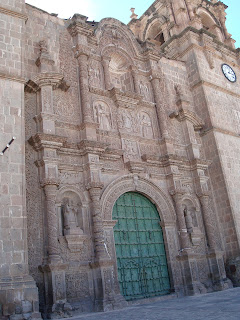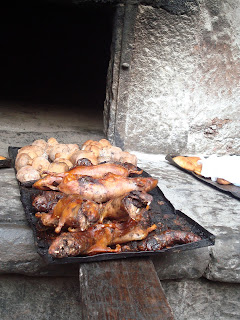We started the morning a little more leisurely as Romulo had organised to meet us at 10:30 am. This gave us time to eat breadkfast and get our blog up to date.
Romulo and the driver were at the hotel as arranged. We started our journey with a little drizzle but by the time we got to the jetty it had cleared. The jetty was well constructed and nice. Romulo explained that because of the rain, the water level is a little higher than normal.
We got on a boat to take us to the Uros Islands - we had quite a large boat to ourselves. The boat had to travel quite slowly. This part of Lake Titikaka is quite shallow but Romulo said that at the deepest point, it is more that 200m deep. Romulo said that Titikaka means 'Grey Puma' in Aymara. The lake is up to 174 km long and up to 64 km wide and is shared between Peru and Bolivia. It would be interesting to get an aerial view of the lake. Romulo explained that there used to be 8 native species of fishes in the lake but introduced species such as trout and king fish has reduced the number of native species to 4 types and of that 2 species are endangered.
Along the way to one of the islands we were going to visit, we saw a pig on one of the reed 'land' and a herd of cows.
There are approximately 900 people living on the islands. We went to an island with about 25 people. On this island we got an explanation on how they made the island. To make an island they must first cut blocks of reed roots and tie them together. They then place layers of reed on top of the root base. They need to anchor the island with rocks. The main diet here is fish, birds, eggs, guinea pigs, potatoes and kiwinua. With the money they make from selling their handicraft, they can buy other goods such as solar panels, television, radio, batteries and things they need. One of the island inhabitants Maria kindly showed us her house. It had a reed bed with blankets, a bed head, small shelves, a small TV and few belongings. Her hut had a solar cell giving her family the luxury of a TV. She embroiders and sells them to get cash. She told us her husband and their 2 children live in the hut.




Life on these islands are certainly very tough. It takes up to 6 months to create an island and twice a year the inhabitants must top up the reeds on their island. When cooking they have to be careful especially during the dry season as it could burn the island down if there were to be uncontrolled spread of fire.
Romulo said that the children do go to schools built for the islands. There are 2 private schools and the teachers are paid with craft, which they sell. There is even a Seventh Day Adventise Church and school here! There are some islands with accommodation for tourists and restaurants and bars.
We got back to land around 1:20pm. Romulo told us about a local cafe Kallosuyo where there is a set menu for 6 sol @ person. He took us there and we had a nice lunch of soup and fish. Very nice and cheap.
Then we went to Casa del Corregidor cafe for a really great cup of coffee. This is local Puno coffee. The cafe had a nice court yard where we sat and enjoyed the delicious coffee. For 5.5 sol a cup, it was worth it. Beside the cafe was a shop selling crafts. Meryl bought a beautiful necklace with humming birds from Arequipa.
Then we went to Museo Carlos Dreyer. Carlos Dreyer was a German artist and collector who had quite a good collection of local artefacts. The museum was small but had a reasonable collection of pre-inca artefacts and religious items. The most interesting exhibition were 3 mummies from Sillustani. Well worth a visit for 15 sol each.
We were so lucky because when we came out from the museum, we noticed that the doors to the main catheral was open so we went in. It had very high ceilings. The building was made from stone, on the outside it had very delicate stone work. It was very beautiful artwork.
Then we walked to the main mall to have another look at the local craft shops. Meryl found a pair of 'lucky' bulls in one of the shops. On our way back to the hotel, we bought a few little things from the street vendors. We were merely helping the local economy.



















































